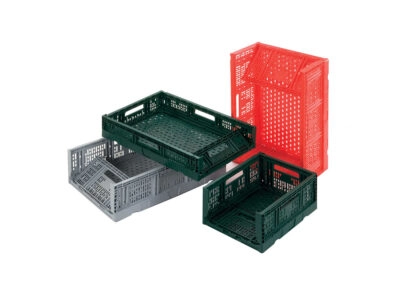Injected Plastic Reusable Packaging
Logimarkt recognizes the importance of packaging in today’s industries. In this context, safety, cost efficiency and sustainability are primary concerns. We strive to offer the most efficient and sustainable packaging solutions.
Injected plastic packaging is a durable option. They withstand many trips and are recyclable into new items at the end of their life cycle. This process consumes less energy than producing new plastic. It can reach up to about 4-5 recycling cycles per product. This ensures long-term use. After these cycles, new material can be introduced. This creates another batch of new crates and packaging solutions.
-

Stackable plastic containers
-

VDA KLT stackable plastic containers
-

Galia boxes
-

ESD boxes
-

ESD plastic pallets and pallets covers
-

Stackable-nestable plastic containers
-

Nestable plastic containers
-

Attached Lid Containers
-

Foldable and collapsible plastic containers
-

Open-front modular bins
-

Foldable Agri crates
-

Plastic pallets
-

Plastic pallet boxes
-

Foldable Large Containers
-

Flatpacs
-

Stacked Frame Containers
-

Plastic Trolleys
-

Big Bag Containers
-

Liquid collecting equipment
-

Label Holders
In the past, cardboard was the preferred choice for packaging. It is perceived as renewable and environmentally friendly. However, a broader perspective reveals the environmental costs related to production, energy consumption, waste and CO2 emissions.
Studies show that the carbon footprint of cardboard remains far higher than that of plastic. This remains the same even if cardboard gets reused several times. Poor storage conditions will disrupt and slow down the natural decay process.
Logimarkt products address a wide range of industries. These include the pharma, food and beverage, transport and automotive industries. Our plastic shipping containers, storage crates, distribution boxes, VDA KLT standard containers, Galia Odette crates and plastic pallets feature high quality durable materials. They are designed to resist heavy use with high static and dynamic load capacities.
They are designed to be long-lasting, easy to wash, clean and disinfect. Further, they are designed to be more ergonomic and compatible for as many uses as possible.
Versatile Injected Plastic Packaging Solutions
Our injected plastic packaging comes in various forms, sizes, and colors, catering to a wide range of needs:
- Stackable Containers: With or without lids, featuring rigid walls, and even detachable lids.
- Foldable Crates: Collapsible walls for easy storage and transport. They are available with or without lids.
- Nestable Boxes: These boxes have conical walls. Their purpose is to save space by nesting inside each other when empty.
- Stack-Nest Containers: Ideal for maximizing space efficiency. For this, they come with stacking accessories and lids.
- KLT Crates (VDA Standard): Conforming to German or Odette Galia standards. These crates find use in the automotive industry.
- Storage Boxes with Frontal Access: Convenient access for various storage needs.
- Pallet Boxes: Available with rigid or foldable walls, feet, skids, and more.
- Plastic Pallets: Featuring closed or open decks, feet, skids, and additional accessories for specialized items.
- Transport Trolleys: Compatible with euro boxes, crates, and containers. These products feature options like fixed wheels, steering casters, and brakes.
- Pallet Systems for Big Bags: Designed for efficient handling of bulk loads.
All of these products can be crafted using antistatic ESD materials.
Optimizing Storage and Transport
Our injection moulded plastic boxes and pallets go beyond sustainability. Packaging offers key advantages for storage and transport:
- Durable: Suitable for heavy, odd-shaped products or goods requiring special protection, like ESD and VCI.
- Stability: Provides increased stability, especially in difficult traffic conditions, which boosts output.
- Versatile Separators: Various separator options, from textiles to corrugated plastic or Duraflex, maximize space use while protecting contents.
- Internal Dunnage: Adapt and customize the interior of containers for specific goods with ease.
- Sturdy Construction: High quality protection against shock, moisture, dust, dust, mould and heat.
- Efficient Space Usage: Stackable design optimizes storage in trucks and warehouses, reducing costs.
- Vertical Efficiency: Utilizes maximum space, allowing more products to be transported without affecting product quality.
- Damage Prevention: Reduces the risk of damage during transit, preventing financial losses.
- Lightweight: Low own weight reduces transport costs without compromising cargo integrity.
- Sustainability: Plastic packaging offers multiple uses. This makes it cost-effective compared to materials like cardboard.
- Automation Compatible: Designed to work seamlessly with all automated handling equipment. These include forklifts, pallet trucks and conveyors.
- Resistance: Provides protection for transported goods. It is resistant to accidental contact with liquids and substances.
- Accessibility: Easy access to content during storage without damaging the packaging.
- Cleanliness: Can be cleaned and disinfected on a frequent basis. Suitable for different temperature and humidity conditions, both indoors and outdoors.
- UV Resistant: Withstands direct sunlight without discolouration thanks to UV treatment.
- Labelling: Easily attach label holders for content control. This facilitates relabelling without damaging the packaging.
- Versatility: Suitable for various products, including fragile components, glass objects, auto components, pharmaceuticals, electronics, waste, and more.
- Food-Safe: Ideal for direct contact with food, using virgin material in the fabrication process.
- Custom-Made: Available in a wide range of versions and dimensions to suit specific needs.
- Cost-Effective Branding: Minimal costs related to imprinting company logos or information. This saves expenses in the long run.
- Transport Suitability: Well-suited for all transport types. They include sea, railway, air, and road. It can handle temperature-sensitive or hazardous contents effectively.






















